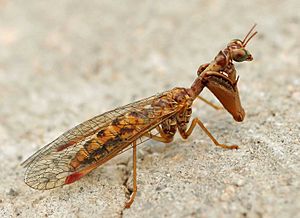Mantidfly facts for kids
Quick facts for kids Mantidflies |
|
|---|---|
 |
|
| Mantispa styriaca | |
| Scientific classification | |
| Kingdom: | |
| Phylum: | |
| Class: | |
| Order: | |
| Suborder: |
Hemerobiiformia
|
| Superfamily: |
Mantispoidea
|
| Family: |
Mantispidae
|
Mantidflies are fascinating insects belonging to the family Mantispidae. They are small to medium-sized insects that are part of the order Neuroptera. There are about 400 different species of mantidflies found all over the world. They are especially common in warm, tropical, and subtropical areas. In Europe, you can find only about 5 species of the Mantispa type.
Contents
What Mantidflies Look Like and How They Live
Some mantidflies are amazing at mimicking wasps. This means they look like wasps to trick other animals. However, most mantidflies are brownish, sometimes with hints of green, yellow, or red.
They get their name because they look a lot like praying mantises. Their front legs are spiky and shaped like a raptor's claws. These special legs are perfect for catching small insect prey. Adult mantidflies are predators, meaning they hunt other insects. They are often active at night, so you might see them near porch lights.
Mantidflies have four clear, thin wings. Sometimes, these wings have patterns, especially in the species that mimic wasps. Even though they are hunters, mantidflies are not very graceful fliers. They catch their prey just like praying mantises do.
The Life Cycle of Mantidflies: Larvae Stages
The young mantidflies, called larvae, have different ways of life. Some are parasitoids, which means they live on or in another animal and eventually cause its death. Others are predators, hunting small creatures.
For example, larvae from the Symphrasinae group are parasitoids. They live on the larvae of bees, wasps, or even scarab beetles. They get their food from these hosts. Larvae from the Calomantispinae group are predators. They hunt and eat small arthropods.
Perhaps the most interesting larvae are from the Mantispinae group. These larvae actively search for female spiders or their egg sacs. Once they find an egg sac, they enter it. The larvae, which look a bit like tiny scarab beetles, then feed on the spider eggs. They use a special tube to pierce the eggs and suck out their contents. After they have eaten enough, they change into a pupa right inside the spider egg sac.
Images for kids
See also
 In Spanish: Mantíspidos para niños
In Spanish: Mantíspidos para niños




